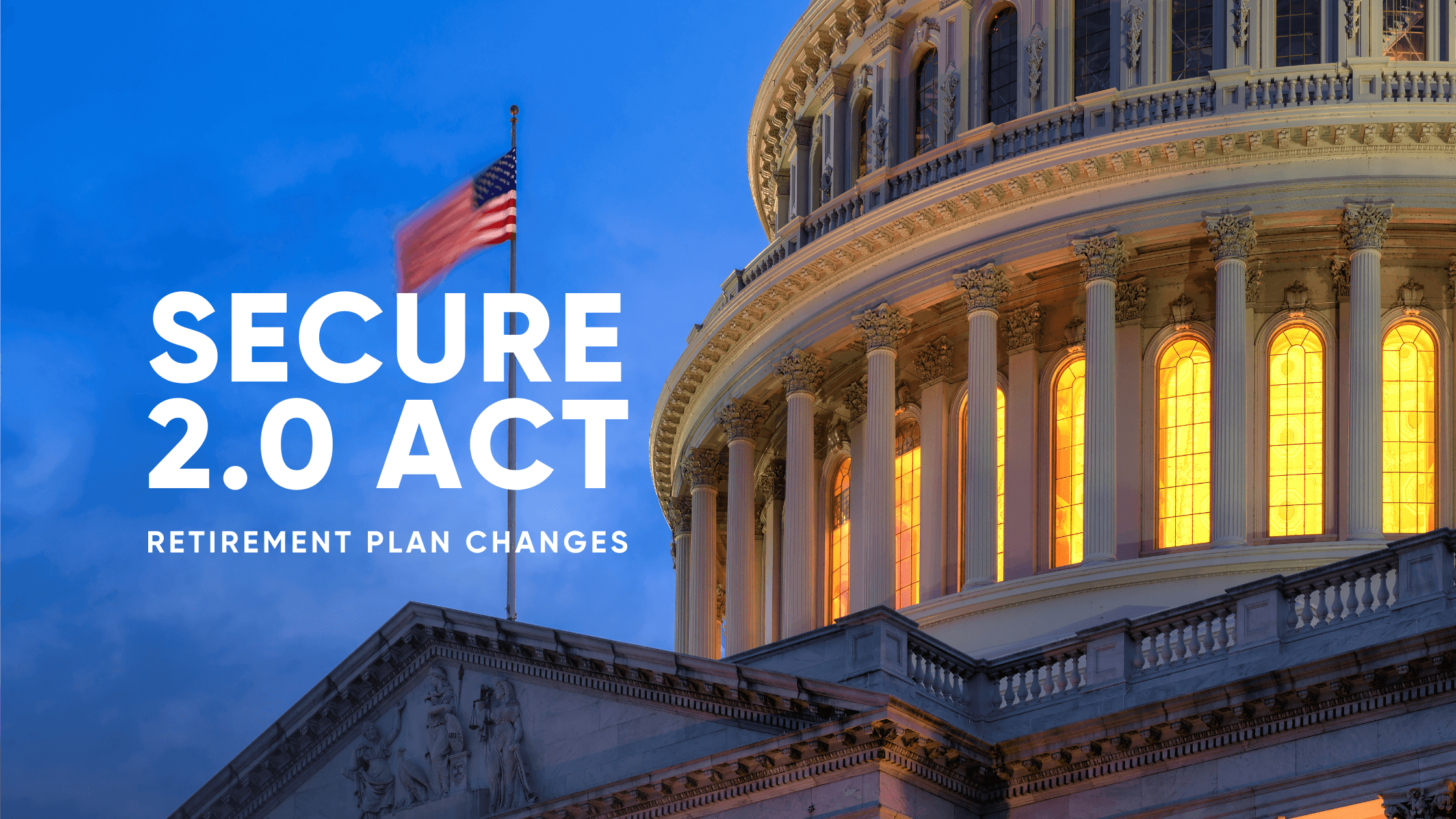SECURE 2.0 Act is shaking up the retirement scene, giving fresh opportunities to both employers and employees. These changes pave the way for a more secure financial future for American workers. Employers can enhance their benefits, increase employee involvement, and potentially lower their expenses, while employees benefit from improved access to retirement plans and flexible saving options. Staying informed is important as the impact of these new regulations is far reaching.
It is no secret that many folks feel uneasy about the U.S. retirement system. Most workers realize that Social Security benefits will not be enough to sustain them during their retirement years. In 2019, a key piece of legislation known as the Setting Every Community Up for Retirement Enhancement Act — or SECURE Act — brought significant changes to retirement-related regulations, particularly affecting small businesses. Here we will address some of the most impactful SECURE Act and SECURE Act 2.0 provisions aimed at strengthening the retirement system and closing the gaps in existing retirement plans.
The SECURE Act of 2019
Described below are some of the key provisions under the SECURE Act of 2019, some of which have since been modified and enhanced under the SECURE 2.0 Act:
- Introducing Tax Credits for Businesses with 100 or Fewer Employees (Small Employer Tax Credits)
- Big Savings on New Plans: Employers may qualify for a tax credit covering up to 50% (maximum of $5,000) of the eligible startup costs for establishing and administering a new retirement plan for the first three years.
- Automatic Enrollment Bonus: Employers may receive an additional $500 tax credit for three years if their retirement plan includes an automatic enrollment feature.
- Expanded Eligibility for Part-Time Workers: Starting in 2024 part-time employees working at least 500 hours in three consecutive years can now contribute to employer-sponsored retirement plans.
- Introduction of Pooled Employer Plans (PEPs): Prior to the SECURE Act, employers could participate in an multiple employer plan (MEP) if they had some common factors with other employers in the plan, such as the same industry or geographic region. The main advantages of joining a MEP are lower costs due to the pooling of assets across all participating employers and reduced administrative and fiduciary responsibilities. With the creation of PEPs, employers with no commonality can now join this new type of multiple employer plan and enjoy the benefits the plan has to offer.
- Flexible Safe Harbor Retirement Plans: Simplified rules for setting up certain Safe Harbor retirement plans allowing for significant employer contributions and employee savings.
- Increased RMD Age: The required minimum distribution (RMD) age was adjusted to 72, allowing more workers to keep their savings tax deferred.
- Continued IRA Contributions: Allowed Individuals who have reached age 70½ to continue contributing to traditional IRAs (Individual Retirement Account).
While the SECURE Act of 2019 was hailed as groundbreaking reform for the retirement system, many believed there was still room for improvement. As a result, we got another major legislation passed in 2022 that included many more retirement plan changes and enhancements.
SECURE 2.0 Act: Groundbreaking Changes and Incentives
The SECURE 2.0 Act is not your average piece of legislation – it’s a game-changer! The Fiscal 2023 Omnibus spending package, signed on December 29, 2022, was a historic moment in retirement legislation as it introduced the SECURE 2.0 Act. This act builds upon the SECURE Act, making crucial changes and adding provisions to boost retirement savings opportunities for both employers and employees. With many provisions set to take effect in 2025, the impact of this legislation will be felt by everyone, no matter where they are on their retirement journey.
Key Provisions of SECURE 2.0 Act:
- Mandatory Automatic Enrollment: Starting in 2025, SECURE 2.0 Act requires employers of new 401(k) plans, including those set up after December 29, 2022, to automatically enroll eligible employees. Employees can opt out of being automatically enrolled if they choose. Those that do not opt out will have 3% of their pay deducted on a pre-tax basis and contributed to the plan. Every year the contribution rate will increase by 1% up to 10% not to exceed 15%. This automatic enrollment feature makes it easier for employees to join retirement plans and start saving.
- Enhanced Small Employer Tax Credits: SECURE 2.0 enhanced some of the existing tax credits and added new tax credits for small businesses sponsoring retirement plans. Notably:
- Full Credit for Start-Up Costs: Businesses with fewer than 50 employees establishing a new 401(k) plan may now be able to receive full credit, meaning 100% of the eligible startup and administrative costs for the first three years of the plan’s existence, up to a maximum of $5,000 per year. The tax credit up to 50% of the eligible startup and administrative costs may still be available to employers with over 50 but fewer than 100 employees.
- Additional Credits for Contributions: Businesses with fewer than 50 employees providing matching or profit-sharing contributions to employees may receive a tax credit of up to $1,000 per employee for five years, with the tax credit amount reduced in years three through five. This was built in to offset the cost of the employer contribution. This credit is also available to employers with over 50 but fewer than 100 employees at a lower rate. If you are currently not offering an employer contribution, this tax incentive might help you improve your employee benefits package significantly.
- Automatic Enrollment Bonus: SECURE 2.0 continues to offer a $500 tax credit to small employers with plans with the eligible automatic enrollment arrangement. This tax credit is especially significant due to a federal mandate that all new 401(k) plans must include an automatic enrollment feature.
- It is important to note that the total amount of tax credits you may be eligible for can be significant, and you should consult with your tax advisor and retirement plan advisor to ensure you are taking full advantage of them.
- Retirement Options for Long-term Part-time Employees: Starting January 1, 2025, part-time employees who have worked at least 500 hours in two consecutive 12-month periods can now join their employer’s retirement plans. Plus, the employer has the flexibility to set a minimum age of 21 and exclude these employees from employer contributions, non-discrimination testing, and top-heavy rules.
- RMD Age Update: SECURE 2.0 Act again increased the required minimum distribution (RMD) age from 72 to 73 beginning January 1, 2023, and from 73 to 75 beginning January 1, 2033.
- Raising the Catch-Up Contribution Limit:
Starting in 2025, 401(k) plans with an age 50 catch-up contribution option, may allow for an increase in the catch-up contribution limit for employees aged 60-63. The catch-up limit for employees in this age group has increased to 150% of the regular catch-up limit, helping individuals boost their retirement savings in their peak earning years.
Navigating the Impact
SECURE 2.0 Act is transforming the retirement industry, giving many opportunities to employers and employees. With these changes, the hope is that a more secure financial future is within reach for all American workers. From improved employer benefits to easier access to retirement plans, the impact is significant. As this legislation progresses and more updates are expected in the upcoming years, it is essential that you stay informed of the possible impacts this regulation will have on your retirement plan and your employees.
This information is being provided for educational purposes only. It should not be construed as providing legal, tax or investment advice and is not designed to be complete in all material respects.





